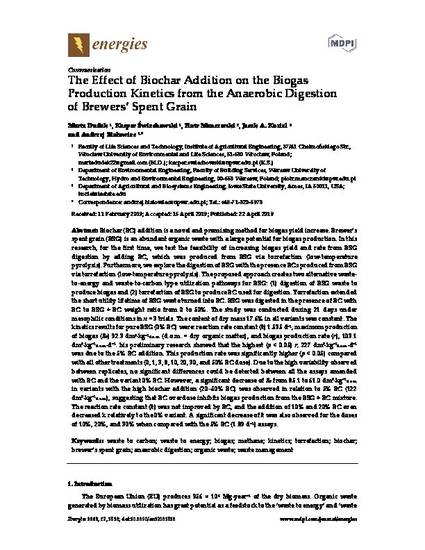
Biochar (BC) addition is a novel and promising method for biogas yield increase. Brewer’s spent grain (BSG) is an abundant organic waste with a large potential for biogas production. In this research, for the first time, we test the feasibility of increasing biogas yield and rate from BSG digestion by adding BC, which was produced from BSG via torrefaction (low-temperature pyrolysis). Furthermore, we explore the digestion of BSG with the presence BCs produced from BSG via torrefaction (low-temperature pyrolysis). The proposed approach creates two alternative waste-to-energy and waste-to-carbon type utilization pathways for BSG: (1) digestion of BSG waste to produce biogas and (2) torrefaction of BSG to produce BC used for digestion. Torrefaction extended the short utility lifetime of BSG waste turned into BC. BSG was digested in the presence of BC with BC to BSG + BC weight ratio from 0 to 50%. The study was conducted during 21 days under mesophilic conditions in n = 3 trials. The content of dry mass 17.6% in all variants was constant. The kinetics results for pure BSG (0% BC) were: reaction rate constant (k) 1.535 d−1, maximum production of biogas (B0) 92.3 dm3∙kg−1d.o.m. (d.o.m. = dry organic matter), and biogas production rate (r), 103.1 dm3∙kg−1d.o.m.∙d−1. his preliminary research showed that the highest (p< 0.05) r,227 dm3∙kg−1d.o.m.∙d−1 was due to the 5% BC addition. This production rate was significantly higher (p< 0.05) compared with all other treatments (0, 1, 3, 8, 10, 20, 30, and 50% BC dose). Due to the high variability observed between replicates, no significant differences could be detected between all the assays amended with BC and the variant 0% BC. However, a significant decrease of B0 from 85.1 to 61.0 dm3∙kg−1d.o.m. in variants with the high biochar addition (20–50% BC) was observed in relation to 5% BC (122 dm3∙kg−1d.o.m.), suggesting that BC overdose inhibits biogas production from the BSG + BC mixture. The reaction rate constant (k) was not improved by BC, and the addition of 10% and 20% BC even decreased k relatively to the 0% variant. A significant decrease of k was also observed for the doses of 10%, 20%, and 30% when compared with the 5% BC (1.89 d−1) assays.
Available at: http://works.bepress.com/jacek_koziel/255/

This article is published as Dudek, M.; Świechowski, K.; Manczarski, P.; Koziel, J.A.; and Białowiec, A. "The Effect of Biochar Addition on the Biogas Production Kinetics from the Anaerobic Digestion of Brewers’ Spent Grain." Energies 12, no. 8 (2019): 1518. DOI: 10.3390/en12081518. Posted with permission.